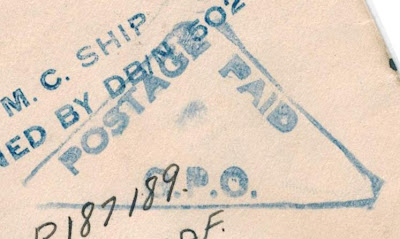Newfoundland and Labrador were of strategic importance during WWII. The entrances to the Gulf of St. Lawrence were controlled by Newfoundland and its main harbour at St. John’s lay astride the main North Atlantic convoy routes. Newfoundland was also a vital link in the trans-Atlantic airway to Britain, with Gander and Goose Bay serving as jumping off points for aircraft and crews flying to Britain to support the war effort.
Markings used on Canadian military mail in Newfoundland
This post provides an overview of Canada's military presence in the Dominion of Newfoundland during the war years and examines how Canadian military mail was handled.
1. Canada's Military Presence
After the fall of France in June, 1940, Newfoundland and Canada agreed that Canada would assume responsibility for the island's defences. The Royal Canadian Navy and the Royal Canadian Air Force used Island facilities as principal bases in the war against German submarines. Army coastal artillery batteries protected shores, and infantry battalions protected the batteries, air bases and other installations at St. John's, Botwood, Gander, Lewisporte, and Goose Bay.
Royal Canadian Air Force (RCAF)
The main R.C.A.F. installations are listed below.
a) Botwood
Botwood was a patrolling and bombing seaplane base, home to two squadrons of PBY Canso flying boats equipped with torpedoes and depth charges.
 |
| RCAF Canso Bomber at Botwood |
b) Gander
The RCAF’s role in Gander was to defend and patrol the western portion of the Atlantic, provide early warning of enemy approach, and defend Gander in the event of attack.. (Gander was also used by the Royal Air Force Ferry Command as a stopover for transporting military aircraft from Canada and the United States to the European theatre.)
 |
| Airman and infantrymen at RCAF Station, Gander, 1943 Hawker Hurricane XII aircraft in the background |
c) Goose Bay, Labrador
Canada built a large air base at Goose Bay, Labrador, as an alternative to Gander for transatlantic operations becoming operational in late 1941. American and British air forces also stationed troopsat Goose Bay.
 |
| Anti-aircraft battery manned by Canadian soldiers Goose Bay, Labrador, May, 1942 |
Torbay, located 8 miles north of St. John's, was home to fighter squadrons that provided protection against U-boats for convoys of ships headed for Britain.
 |
| RCAF Pilots of No.125(F) Squadron Torbay air base, 1942 |
Canadian Army "W" Force
After Canada agreed to assume the responsibility for Newfoundland’s defense and coastal artillery in 1940, infantry battalions of the "W" force were strategically placed to protect installations at St. John’s, Botwood, Gander, Lewisporte and others. By 1943, there were over 6,000 army troops in Newfoundland.
 |
| An infantryman with the Black Watch mans a machine gun position Botwood 1940 |
Royal Canadian Navy
H.M C.S. Avalon, the Royal Canadian Navy (RCN) base at St. John's was an important escort base,whose responsibility was the supply and maintenance of the trans-Atlantic escorts that sailed with convoys. By May 1945, 5000 personnel were serving at St. John's.
 |
| Royal Canadian Navy Operations Room, St. John’s September 24, 1942. |
a) Canadian Army and Royal Canadian Air Force
The Canadian Postal Corps established 6 post offices in Newfoundland and Labrador to service Canadian Army and Royal Canadian Air Force mail.
C.A.P.O. No. 1 St. John's
C.A.P.O. No. 1 to Toronto, November 12, 1944
 |
| C.A.P.O. No. 1 |
Ft. Erie North & Brantford R.P.O. to C.A.P.O. No, 1, April 8, 1944
6 cents concession air mail rate
C.A.P.O. No. 2 Gander
Canadian Army "W" Force, Infantry, C.A.P.O. No. 2 Gander to Niagara Falls, December 11, 1941
 |
| "PASSED BY MILITARY CENSOR NO. 13." |
Canadian Army "W" Force, Artillery, C.A.P.O. No. 2 Gander to Limoilou, July 20, 1944
26th Light Anti-Aircraft Regiment
26th Light Anti-Aircraft Regiment
C.A.P.O. No. 3 Botwood
No. 30 Radar Detachment, Quirpon Island, Newfoundland
The R.C.A.F. manned radar stations on the east and west coasts of Canada as well as in Newfoundland. The radar unit on Quirpon Island at the most northerly tip of Newfoundland became operational in late 1942.
 |
| No. 30 Radar Detachment, Quirpon Island to Toronto C.A.P.O. No. 3 (Botwood), June 26, 1943 |
C.A.P.O. No.4 Gander (R.C.A.F.)
C.A.P.O. No. 4 Gander (R.C.A.F.) to Rockcliffe Station, Ottawa, November 10, 1942
C.A.P.O. No. 5 Torbay
 |
| C.A.P.O. No. 10 Goose Bay, Labrador (R.C.A.F.) to Hespeler, November 30, 1943 Free Mail "R.C.A.F. ON ACTIVE SERVICE" |
 |
| Money Order receipts with C.A.P.O. No. 10 Money Order Office Date Stamp |
b) Royal Canadian Navy
A naval post office was established at the H.M.S. Avalon naval base handling mail from the base and mail from ships in transit. Mail received from ships at sea was free for surface letters. However, if air mail service was requested, the air mail fee was to be paid. For security reasons, there was no indication on the mail, i.e. Newfoundland postage stamps or postal markings, that the mail came from HMCS Avalon.
Postage Paid G.P.O.
Mail that required postage such as air mail letters and registered mail were brought to the St. John's General Post Office where the fees were paid and a triangular "Postage Paid G.P.O." handstamp was applied.
(Reference Bailey and Toop, Proud Series, The Canadian Military Posts, Volume 2)
Ship mail, censored June 27, 1942
Air mail postage paid
 |
This was posted by my friend's Father at sea from a mine sweeper.
Thought you would like it |

Received at H.M.C.S. Avalon and addressed to London, Ontario
London transit July 24, 1943 (letter redirected)
Air mail letter with 3 cent Canadian stamp affixed to Dorchester, Mass., September 16, 1942
Received at HMCS Avalon
Air mail fee paid and handstamped "POSTAGE PAID G.P.O."
 |
| Navy ship censor marking |



























